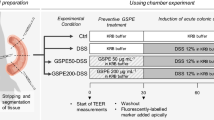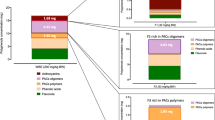Abstract
Background
Dietary approaches to control inflammatory bowel diseases (IBD) may include proanthocyanidin-rich foods. Our previous research showed that a hydrophilic extract from Sicilian pistachio nut (HPE) contains substantial amounts of proanthocyanidins and possesses anti-inflammatory activities.
Purpose
We studied the effects of HPE and of its polymeric proanthocyanidin fraction (PPF) in a cell model that simulated some conditions of IBD, consisting of interleukin (IL)-1β-stimulated Caco-2 cells.
Methods
HPE was prepared by Pistacia vera L. nuts, and PPF was isolated from HPE by adsorbance chromatography. Proanthocyanidins were quantified as anthocyanidins after acidic hydrolysis. Differentiated Caco-2 cells were pre-incubated with HPE or PPF and then were exposed to IL-1β. Cell viability and parameters associated with nuclear factor-κB (NF-κB) activation were assayed. Adsorption of polymeric proanthocyanidins to the cell membrane was investigated by transepithelial electrical resistance (TEER) measurements.
Results
HPE decreased prostaglandin (PG)E2 production, IL-6 and IL-8 release, and cyclooxygenase (COX)-2 expression. HPE also inhibited the increase in paracellular permeability and reduced NF-κB activation. Polymeric proanthocyanidins, tested at a concentration comparable with their content in HPE, produced effects comparable to HPE. Finally, cell exposure to PPF increases TEER of the epithelial monolayers.
Conclusion
Our results provide evidence that pistachio nut components inhibit inflammatory response of intestinal epithelial cells in vitro and indicate polymeric proanthocyanidins as the major bioactive nut components. The protection implies inhibition of NF-κB activation and occurs in parallel with the adsorption of polymeric proanthocyanidins to cell membrane. Our findings suggest that intake of small amounts of pistachio nut can exert beneficial effects to gastrointestinal pathophysiology.







Similar content being viewed by others
References
MacDermott RP (1996) Alterations of the mucosal immune system in inflammatory bowel disease. J Gastroenterol 31(6):907–916. doi:10.1007/bf02358624
Sartor RB (1997) Pathogenesis and immune mechanisms of chronic inflammatory bowel diseases. Am J Gastroenterol 92(12 Suppl):5S–11S
Netsch MI, Gutmann H, Aydogan C, Drewe J (2006) Green tea extract induces interleukin-8 (IL-8) mRNA and protein expression but specifically inhibits IL-8 secretion in caco-2 cells. Planta Med 72(8):697–702. doi:10.1055/s-2006-931597
Basu A, Penugonda K (2009) Pomegranate juice: a heart-healthy fruit juice. Nutr Rev 67(1):49–56. doi:10.1111/j.1753-4887.2008.00133.x
Mitjavila MT, Moreno JJ (2012) The effects of polyphenols on oxidative stress and the arachidonic acid cascade. Implications for the prevention/treatment of high prevalence diseases. Biochem Pharmacol 84(9):1113–1122. doi:10.1016/j.bcp.2012.07.017
Rasmussen SE, Frederiksen H, Struntze Krogholm K, Poulsen L (2005) Dietary proanthocyanidins: occurrence, dietary intake, bioavailability, and protection against cardiovascular disease. Mol Nutr Food Res 49(2):159–174. doi:10.1002/mnfr.200400082
Spencer JP, Chaudry F, Pannala AS, Srai SK, Debnam E, Rice-Evans C (2000) Decomposition of cocoa procyanidins in the gastric milieu. Biochem Biophys Res Commun 272(1):236–241. doi:10.1006/bbrc.2000.2749
Rios LY, Bennett RN, Lazarus SA, Rémésy C, Scalbert A, Williamson G (2002) Cocoa procyanidins are stable during gastric transit in humans. Am J Clin Nutr 76(5):1106–1110
Deprez S, Mila I, Huneau JF, Tome D, Scalbert A (2001) Transport of proanthocyanidin dimer, trimer, and polymer across monolayers of human intestinal epithelial Caco-2 cells. Antioxid Redox Signal 3(6):957–967. doi:10.1089/152308601317203503
Yoshioka Y, Akiyama H, Nakano M, Shoji T, Kanda T, Ohtake Y, Takita T, Matsuda R, Maitani T (2008) Orally administered apple procyanidins protect against experimental inflammatory bowel disease in mice. Int Immunopharmacol 8(13–14):1802–1807. doi:10.1016/j.intimp.2008.08.021
Li XL, Cai YQ, Qin H, Wu YJ (2008) Therapeutic effect and mechanism of proanthocyanidins from grape seeds in rats with TNBS-induced ulcerative colitis. Can J Physiol Pharmacol 86(12):841–849. doi:10.1139/Y08-089
Wang YH, Yang XL, Wang L, Cui MX, Cai YQ, Li XL, Wu YJ (2010) Effects of proanthocyanidins from grape seed on treatment of recurrent ulcerative colitis in rats. Can J Physiol Pharmacol 88(9):888–898. doi:10.1139/y10-071
Nandakumar V, Singh T, Katiyar SK (2008) Multi-targeted prevention and therapy of cancer by proanthocyanidins. Cancer Lett 269(2):378–387. doi:10.1016/j.canlet.2008.03.049
Velmurugan B, Singh RP, Kaul N, Agarwal R, Agarwal C (2010) Dietary feeding of grape seed extract prevents intestinal tumorigenesis in APCmin/+ mice. Neoplasia 12(1):95–102. doi:10.1593/neo.91718
Edwards K, Kwaw I, Matud J, Kurtz I (1999) Effect of pistachio nuts on serum lipid levels in patients with moderate hypercholesterolemia. J Am Coll Nutr 18(3):229–232. doi:10.1080/07315724.1999.10718856
Kocyigit A, Koylu AA, Keles H (2006) Effects of pistachio nuts consumption on plasma lipid profile and oxidative status in healthy volunteers. Nutr Metab Cardiovasc Dis 16(3):202–209. doi:10.1016/j.numecd.2005.08.004
Sheridan MJ, Cooper JN, Erario M, Cheifetz CE (2007) Pistachio nut consumption and serum lipid levels. J Am Coll Nutr 26(2):141–148. doi:10.1080/07315724.2007.10719595
Sari I, Baltaci Y, Bagci C, Davutoglu V, Erel O, Celik H, Ozer O, Aksoy N, Aksoy M (2010) Effect of pistachio diet on lipid parameters, endothelial function, inflammation, and oxidative status: a prospective study. Nutrition 26(4):399–404. doi:10.1016/j.nut.2009.05.023
Gentile C, Tesoriere L, Butera D, Fazzari M, Monastero M, Allegra M, Livrea MA (2007) Antioxidant activity of Sicilian pistachio (Pistacia vera L. var. Bronte) nut extract and its bioactive components. J Agric Food Chem 55(3):643–648. doi:10.1021/jf062533i
Gentile C, Allegra M, Angileri F, Pintaudi AM, Livrea MA, Tesoriere L (2012) Polymeric proanthocyanidins from Sicilian pistachio (Pistacia vera L.) nut extract inhibit lipopolysaccharide-induced inflammatory response in RAW 264.7 cells. Eur J Nutr 51(3):353–363. doi:10.1007/s00394-011-0220-5
Jordão AM, Gonçalves FJ, Correia AC, Cantão J, Rivero-Pérez MD, González Sanjosé ML (2010) Proanthocyanidin content, antioxidant capacity and scavenger activity of Portuguese sparkling wines (Bairrada Appellation of Origin). J Sci Food Agric 90:2144–2152. doi:10.1002/jsfa.4064
Porter LJ, Hrstich LN, Chan BG (1985) The conversion of procyanidin and prodelphinidins to cyanidin and delphinidin. Phytochemistry 25:223–230. doi:10.1016/S0031-9422(00)94533-3
Tesoriere L, Attanzio A, Allegra M, Gentile C, Livrea MA (2014) Indicaxanthin inhibits NADPH oxidase (NOX)-1 activation and NF-κB-dependent release of inflammatory mediators and prevents the increase of epithelial permeability in IL-1β-exposed Caco-2 cells. Br J Nutr 111(3):415–423. doi:10.1017/S0007114513002663
Banan A, Choudhary S, Zhang Y, Fields JZ, Keshavarzian A (2000) Oxidant-induced intestinal barrier disruption and its prevention by growth factors in a human colonic cell line: role of the microtubule cytoskeleton. Free Radic Biol Med 28(5):727–738. doi:10.1016/S0891-5849(00)00160-X
Tesoriere L, Gentile C, Angileri F, Attanzio A, Tutone M, Allegra M, Livrea MA (2013) Trans-epithelial transport of the betalain pigments indicaxanthin and betanin across Caco-2 cell monolayers and influence of food matrix. Eur J Nutr 52(3):1077–1087. doi:10.1007/s00394-012-0414-5
Artursson P (1990) Epithelial transport of drugs in cell culture. I: a model for studying the passive diffusion of drugs over intestinal (Caco-2) absorptive cells. J Pharm Sci 79:476–482. doi:10.1002/jps.2600790604
Wang D, Dubois RN (2010) The role of COX-2 in intestinal inflammation and colorectal cancer. Oncogene 29(6):781–788. doi:10.1038/onc.2009.421
Barnes PJ (1997) Nuclear factor-kappa B. Int J Biochem Cell Biol 29(6):867–870. doi:10.1016/S1357-2725(96)00159-8
Al-Sadi RM, Ma TY (2007) IL-1beta causes an increase in intestinal epithelial tight junction permeability. J Immunol 178(7):4641–4649
Walgren RA, Walle UK, Walle T, Wang YH (1998) Transport of quercetin and its glucosides across human intestinal epithelial Caco-2 cells. Biochem Pharmacol 55(10):1721–1727. doi:10.1016/S0006-2952(98)00048-3
Werner T, Haller D (2007) Intestinal epithelial cell signalling and chronic inflammation: from the proteome to specific molecular mechanisms. Mutat Res 622(1–2):42–57. doi:10.1016/j.mrfmmm.2007.05.010
Daig R, Andus T, Aschenbrenner E, Falk W, Scholmerich J, Gross V (1996) Increased interleukin 8 expression in the colon mucosa of patients with inflammatory bowel disease. Gut 38:216–222. doi:10.1136/gut.38.2.216
Romier-Crouzet B, Van De Walle J, During A, Joly A, Rousseau C, Henry O, Larondelle Y, Schneider YJ (2009) Inhibition of inflammatory mediators by polyphenolic plant extracts in human intestinal Caco-2 cells. Food Chem Toxicol 47(6):1221–1230. doi:10.1016/j.fct.2009.02.015
Duque J, Díaz-Muñoz MD, Fresno M, Iñiguez MA (2006) Up-regulation of cyclooxygenase-2 by interleukin-1beta in colon carcinoma cells. Cell Signal 18(8):1262–1269. doi:10.1016/j.cellsig.2005.10.009
Wullaert A, Bonnet MC, Pasparakis M (2011) NF-κB in the regulation of epithelial homeostasis and inflammation. Cell Res 21(1):146–158. doi:10.1038/cr.2010.175
Van De Walle J, Hendrickx A, Romier B, Larondelle Y, Schneider YJ (2010) Inflammatory parameters in Caco-2 cells: effect of stimuli nature, concentration, combination and cell differentiation. Toxicol In Vitro 24(5):1441–1449. doi:10.1016/j.tiv.2010.04.002
Erlejman AG, Jaggers G, Fraga CG, Oteiza PI (2008) TNFalpha-induced NF-kappaB activation and cell oxidant production are modulated by hexameric procyanidins in Caco-2 cells. Arch Biochem Biophys 476(2):186–195. doi:10.1016/j.abb.2008.01.024
Bruewer M, Luegering A, Kucharzik T, Parkos CA, Madara JL, Hopkins AM, Nusrat A (2003) Proinflammatory cytokines disrupt epithelial barrier function by apoptosis-independent mechanisms. J Immunol 171(11):6164–6172
DeMeo MT, Mutlu EA, Keshavarzian A, Tobin MC (2002) Intestinal permeation and gastrointestinal disease. J Clin Gastroenterol 34(4):385–396. doi:10.1097/00004836-200204000-00003
Erlejman AG, Fraga CG, Oteiza PI (2006) Procyanidins protect Caco-2 cells from bile acid- and oxidant-induced damage. Free Radic Biol Med 41(8):1247–1256. doi:10.1016/j.freeradbiomed.2006.07.002
Verstraeten SV, Keen CL, Schmitz HH, Fraga CG, Oteiza PI (2003) Flavan-3-ols and procyanidins protect liposomes against lipid oxidation and disruption of the bilayer structure. Free Radic Biol Med 34(1):84–92. doi:10.1016/S0891-5849(02)01185-1
Williams RJ, Spencer JP, Rice-Evans C (2004) Flavonoids: antioxidants or signalling molecules? Free Radic Biol Med 36:838–849
Erlejman AG, Verstraeten SV, Fraga CG, Oteiza PI (2004) The interaction of flavonoids with membranes: potential determinant of flavonoid antioxidant effects. Free Radic Res 38(12):1311–1320. doi:10.1080/10715760400016105
Da Silva M, Jaggers GK, Verstraeten SV, Erlejman AG, Fraga CG, Oteiza PI (2012) Large procyanidins prevent bile-acid-induced oxidant production and membrane-initiated ERK1/2, p38, and Akt activation in Caco-2 cells. Free Radic Biol Med 52(1):151–159. doi:10.1016/j.freeradbiomed.2011.10.436
Mahe S, Huneau JF, Marteau P, Thuillier F, Tome D (1992) Gastroileal nitrogen and humans. Am J Clin Nutr 56:410–441
Fraga CG, Galleano M, Verstraeten SV, Oteiza PI (2010) Basic biochemical mechanisms behind the health benefits of polyphenols. Mol Aspects Med 31(6):435–445. doi:10.1016/j.mam.2010.09.006
Dixon RA, Xie DY, Sharma SB (2005) Proanthocyanidins—a final frontier in flavonoid research? New Phytol 165(1):9–28. doi:10.1111/j.1469-8137.2004.01217.x
Ruiz PA, Haller D (2006) Functional diversity of flavonoids in the inhibition of the proinflammatory NF-kappaB, IRF, and Akt signaling pathways in murine intestinal epithelial cells. J Nutr 136(3):664–671
Romier B, Van De Walle J, During A, Larondelle Y, Schneider YJ (2008) Modulation of signalling nuclear factor-kB activation pathway by polyphenols in human intestinal Caco-2 cells. Br J Nutr 100:542–551. doi:10.1017/S0007114508966666
Sergent T, Piront N, Meurice J, Toussaint O, Schneider YJ (2010) Anti-inflammatory effects of dietary phenolic compounds in an in vitro model of inflamed human intestinal epithelium. Chem Biol Interact 188(3):659–667. doi:10.1016/j.cbi.2010.08.007
Seibel J, Molzberger AF, Hertrampf T, Laudenbach-Leschowski U, Diel P (2009) Oral treatment with genistein reduces the expression of molecular and biochemical markers of inflammation in a rat model of chronic TNBS-induced colitis. Eur J Nutr 48(4):213–220. doi:10.1007/s00394-009-0004-3
Morimoto M, Watanabe T, Yamori M, Takebe M, Wakatsuki Y (2009) Isoflavones regulate innate immunity and inhibit experimental colitis. J Gastroenterol Hepatol 24(6):1123–1129. doi:10.1111/j.1440-1746.2008.05714.x
Conflict of interest
On behalf of all authors, the corresponding author states that there is no conflict of interest.
Author information
Authors and Affiliations
Corresponding author
Rights and permissions
About this article
Cite this article
Gentile, C., Perrone, A., Attanzio, A. et al. Sicilian pistachio (Pistacia vera L.) nut inhibits expression and release of inflammatory mediators and reverts the increase of paracellular permeability in IL-1β-exposed human intestinal epithelial cells. Eur J Nutr 54, 811–821 (2015). https://doi.org/10.1007/s00394-014-0760-6
Received:
Accepted:
Published:
Issue Date:
DOI: https://doi.org/10.1007/s00394-014-0760-6




